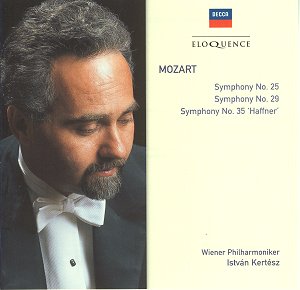The loss of a musician
like Kertész is something felt
even today, over thirty years after
his untimely death at the age of 43.
These recordings, made a year or so
beforehand as part of a Mozart cycle,
demonstrate just what a fine musician
he was. They also show up today’s genuine
shortage of conducting talent on this
level.
True, Kertész
is greatly assisted by an unparalleled
orchestra (for me at least the VPO is
preferable to the harder-edged Berliners
in Mozart), the fabulous acoustic of
the Sofiensaal and the Decca engineering
team of Christopher Raeburn and James
Lock. In the early 1970s this production
team probably knew the orchestra and
hall better than anyone as far as recordings
are concerned. There is no doubt that
all deserve credit for their part in
the results.
But listen to what
Kertész delivers. Finely paced
readings – many do that – but with a
clear sense of the inner relationship
of the parts, textures and therefore
the drama that results. All of this
is delivered in a manner that seems
unpushed beyond what is needed by or
natural to the music. It’s almost as
if the conductor is not there, that
the music plays itself. Well, Kertész
is there, just not his ego. This, according
to a friend of mine who knew Kertész
in Hungary, was typical of the man and
his approach to conducting.
Given that the Vienna
Philharmonic have Mozart in their very
being, the approach pays off. Tempi
at first seem nothing beyond the ordinary,
but combine them with the natural weight
of the orchestra and the balance of
the works is clearly established. This
assists voicing, articulation and emphasis
to deploy all with great style.
Strings are immediate,
nicely so in the lower registers, illustrating
the keen sense Kertész had of
building orchestral sound. Winds have
great character and presence. The brass
placed in context to the whole, with
bite, yet never drowning out the rest.
So, amazingly, I have
reviewed the performance of three symphonies
without mentioning a single one specifically.
However I believe that in listening
to this recording, you will be able
to identify the characteristics in each
as they progress. I was particularly
glad to reacquaint myself with the Haffner,
a favourite performance that I had on
tape around twenty years ago, that was
played to self-destruction. But the
discovery was the immensely distinguished
account of Symphony 29. A finer
account I do not think I have ever heard.
Quite a bargain too
at the prices charged through the buywell
website, so why not pick up a few other
Kertész volumes while you’re
at it. You can hardly go far wrong.
Evan Dickerson


